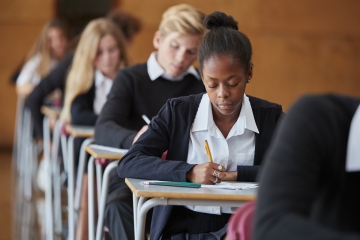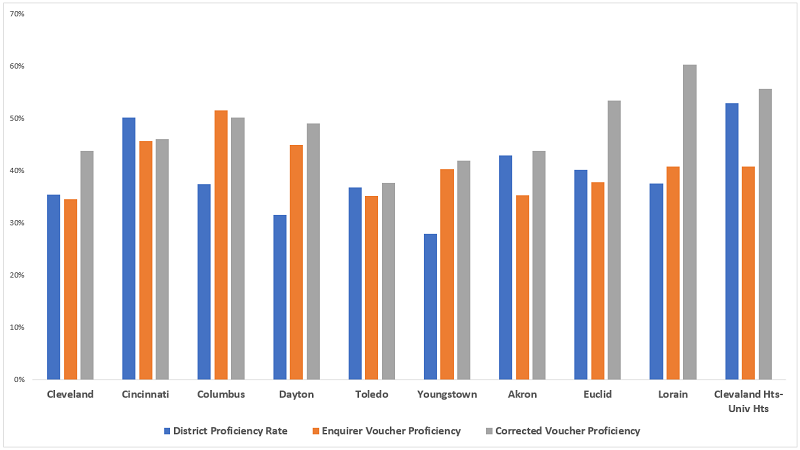It’s been a banner year for private school choice in Ohio. Senate Bill 89, which became law this spring, wisely decoupled the state’s EdChoice Scholarship Program from school report card ratings and expanded eligibility to more middle-income families. The state budget built on these improvements by creating a new school funding model that directly funds choice programs, expanding eligibility provisions even further, and increasing scholarship funding amounts.
These changes are a big win for everyday Ohioans who are searching for the best educational fit for their children. But for public school advocates who view choice as a threat, the state’s actions appear to represent yet another harbinger of doom. Their disdain for EdChoice, in particular, is clear in their comments from a recent piece published by the Columbus Dispatch, which purports to take a look at how vouchers gained popularity in Ohio. Amidst the history lesson there are some inaccurate, misleading, and downright troublesome assertions made by voucher critics. Let’s take a look at three of the most egregious.
Claim 1: Private school scholarships drain money from public schools
This is one of the most common arguments against private school choice—and choice more generally—so it’s no surprise that it shows up in the Dispatch piece. In fact, the total cost of educational vouchers during the 2021–22 school year (approximately $628 million) is referenced more than once. Ohio Federation of Teachers president Melissa Cropper even goes so far as to say there is “something wrong” with the state spending so much. She adds: “Even though the money might not be directly taken from a school district right now, there is still only so much state money allocated for education.”
It’s true that the state has a finite amount of money to devote to education. But acting as though EdChoice carries a burdensome price tag that taxpayers wouldn’t have to shoulder if vouchers disappeared isn’t accurate. If a student opts to attend a private school using an EdChoice scholarship, the state money designated for that student simply follows them to the school that’s doing the work of educating them. That’s how student-centered funding works. Moreover, taxpayers don’t pay more when students use vouchers. In fact, for years, Ohioans have actually saved money when students use a voucher. That’s because voucher amounts add up to far less than the overall taxpayer support required to educate a student who attends a district school. Even with scholarship amounts increasing under the new budget, vouchers will still be funded at far more modest amounts than the statewide average per pupil expenditure.
It’s also unfair to claim that voucher programs rob districts of money. First and foremost, no school—district, charter, private, or otherwise—is entitled to students. Families have the right to choose where to send their children to school, and schools are allocated money based on students they actually teach, not students they could have taught. To do otherwise would be to prioritize systems—one specific system—over students.
Second, it’s important to remember that schools are funded by state and local dollars. On average, 45 percent of elementary and secondary public school revenues are from local sources. For the most part, these dollars aren’t tied to student enrollment. Districts receive tax payments from their residents regardless of whether those residents have children that attend the district. And contrary to widespread claims that school choice results in lost funding, Ohio data show that per-pupil funding actually increased between 2000 and 2019 in districts where charters and private schools have historically been the most prevalent.
Finally, although districts’ complaints about losing money might have been understandable when the state funded voucher programs through deductions to districts’ state aid, that’s no longer the case. The recently passed state budget included a complete overhaul of the school funding formula. As Cropper noted above, money is no longer “directly taken” from districts. There is, quite literally, no loss of funding for districts when a student opts to use a voucher.
Claim 2: School choice is at odds with improving public schools
This is another anti-choice talking point that’s mentioned in the Dispatch. The piece notes that the “thorough and efficient system of common schools” promised by the Ohio Constitution is a mandate to “fix” underperforming public schools. The underlying implication is that rather than paying for families to “escape” to private schools, we should be focusing all our money and attention on improving public schools. This is always framed as an either/or. Policymakers and advocates can either focus on improving traditional public schools, or they can focus on expanding choice programs. They can’t do both.
But that’s a false dilemma. There’s no reason that traditional public schools can’t improve and thrive alongside private and charter schools. In fact, one of the great arguments in favor of choice is that it can spur change and innovation in nearby districts. Cleveland is proof positive of that. The district was recently named one of the fastest-improving school districts in the country. It is one of only three districts in a nationwide sample that succeeded in improving from negative to positive NAEP impacts between 2009 and 2019. And all of this was accomplished despite the fact—or perhaps because of the fact—that Cleveland students have had access to private school scholarships since 1995 plus a burgeoning charter school sector. A portfolio of school options can breed competition between different types of schools, but it can also lead to collaboration if adults are willing. In either case, students benefit. That’s all that should matter.
Claim 3: If parents want their children to attend private schools, they should pay for it
This argument makes an appearance courtesy of Senator Teresa Fedor, who told Dispatch reporters: “I went to private schools, I taught at private schools, I sent my son to a private school, and it was by my choice...I did not expect the public to pay for it.”
There’s a lot wrong with this way of thinking. First and foremost is the Senator’s assumption that, just because she can afford to attend and send her children to private schools, everyone in Ohio can. But according to the 2021 State of Poverty in Ohio report, nearly 3.5 million Ohioans—more than three out of every ten—live below 200 percent of the federal poverty line. That translates to an annual income of $53,000 for a family of four. Meanwhile, average private school tuition in Ohio clocks in at just over $7,000. Without assistance from the state, low-income parents with two kids would need to spend more than a fourth of their annual income just to afford private school tuition. Spending that much isn’t feasible.
Of course, Senator Fedor and others would argue that every Ohio student has access to free public schools. And that’s true. But free doesn’t always equate to good. Consider Toledo, which is part of the district that Senator Fedor represents. On the 2018–19 report card (the last report card with graded components), Toledo Public Schools (TPS) earned an F in achievement and a D in progress. Value-added grades for students with disabilities and the lowest-performing 20 percent of students were F’s. And the four-year graduation rate was only 79 percent compared to the state average of 85 percent.
Parents of students in TPS could wait for the district to turn itself around and improve. That is, after all, what voucher opponents advocate for when they say that state leaders should focus on improving public schools rather than giving families access to other options. But what if families—families just like Senator Fedor’s—aren’t willing to risk their child’s future on a potentially empty promise that their neighborhood school will suddenly improve? Districts like TPS have nearly a decade of poor report card results under their belts, in addition to high remediation rates and low ACT and SAT scores. What if families dare to want something better for their children now?
Unlike their senator, most Toledo parents can’t afford to pay private school tuition. Of the nearly 23,000 students TPS educates, 87 percent are considered economically disadvantaged. The median household income in Toledo is just below $38,000, which means the average annual private school tuition bill would amount to almost a fifth of a household’s annual income. Moving to a nearby district is likely out of the question, considering the average home price in neighboring, higher-performing districts like Perrysburg ($274,877) and Ottawa Hills ($333,571). Open enrollment isn’t an option either, since most of the districts that surround TPS have closed borders. There are charter schools, of course, but seats are limited.
The upshot? Without private school scholarships, lower- and middle-income families who want a different or better option are out of luck. That seems like a problem Senator Fedor should be working to solve. Instead, she’s calling for these programs to be eliminated or scaled back.
***
When it comes to debates over school choice, misrepresentations are nothing new. Given the wide variety of choice-friendly provisions in the budget, it’s not surprising that the establishment is hitting back. But the complaints refuted here—and several others that appear unchallenged in the Dispatch piece—are inaccurate at best. Ohioans deserve better.










